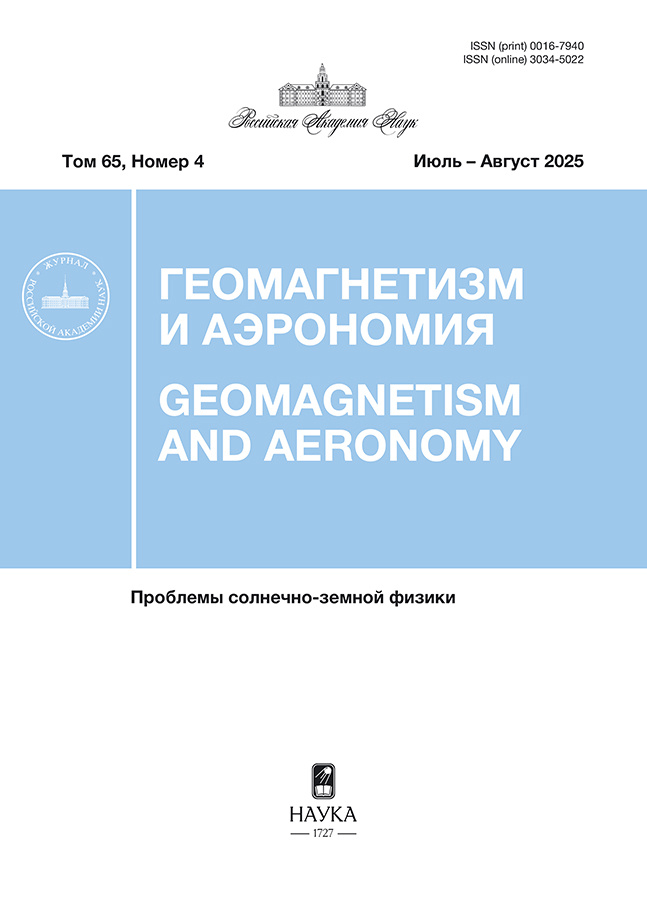Восстановление векторного магнитного поля по однокомпонентным данным с использованием эволюционного алгоритма
- Авторы: Рытов Р.А.1, Усов Н.А.1, Петров В.Г.1
-
Учреждения:
- Институт земного магнетизма, ионосферы и распространения радиоволн им. Н.В.Пушкова РАН (ИЗМИРАН)
- Выпуск: Том 64, № 4 (2024)
- Страницы: 567-576
- Раздел: Статьи
- URL: https://ter-arkhiv.ru/0016-7940/article/view/650925
- DOI: https://doi.org/10.31857/S0016794024040104
- EDN: https://elibrary.ru/RSQEXY
- ID: 650925
Цитировать
Полный текст
Аннотация
Предложен простой эволюционный алгоритм для восстановления вектора аномального магнитного поля по данным измерения одной его компоненты. Алгоритм подбирает положения и магнитные моменты ансамбля точечных магнитных диполей, совокупное магнитное поле которых приближает с необходимой точностью данные однокомпонентных магнитных измерений на известной высоте над земной поверхностью. Найденное таким образом распределение источников позволяет восстановить все три компоненты магнитного поля. В данной работе с помощью эволюционного алгоритма решена задача восстановления компонент Hx и Hy магнитного поля по данным измеренной вертикальной Hz-компоненты. Предложена также итерационная процедура для расчета Hx , Hy , Hz-компонент магнитного поля по известным данным для аномальной составляющей геомагнитного поля.
Об авторах
Р. А. Рытов
Институт земного магнетизма, ионосферы и распространения радиоволн им. Н.В.Пушкова РАН (ИЗМИРАН)
Автор, ответственный за переписку.
Email: ruslan.rytov2017@ya.ru
Россия, Москва, Троицк
Н. А. Усов
Институт земного магнетизма, ионосферы и распространения радиоволн им. Н.В.Пушкова РАН (ИЗМИРАН)
Email: usov@obninsk.ru
Россия, Москва, Троицк
В. Г. Петров
Институт земного магнетизма, ионосферы и распространения радиоволн им. Н.В.Пушкова РАН (ИЗМИРАН)
Email: vgpetrov2018@mail.ru
Россия, Москва, Троицк
Список литературы
- Колесова В.И. Аналитические методы магнитной картографии. Отв. ред. В.И. Почтарев. Москва: Наука, 222 c. 1985.
- Яновский Б.М. Земной магнетизм. Ленинград : Изд-во ЛГУ, 591 c. 1978.
- Alken P., Thébault E., Beggan C.D., et al. International Geomagnetic Reference Field: the thirteenth generation // Earth Planets and Space. V. 73. № 1. 2021. doi: 10.1186/s40623-020-01288-x
- Arturi C.M., Di Rienzo L., Haueisen J. Information Content in Single-Component Versus Three-Component Cardiomagnetic Fields // IEEE Transactions on Magnetics. V. 40. № 2. P. 631–634. 2004. doi: 10.1109/tmag.2004.824891
- Baniamerian J., Liu S., Hu X., Fedi M., Chauhan M.S., Abbas M.A. Separation of magnetic anomalies into induced and remanent magnetization contributions // Geophysical Prospecting. V. 68. № 7. P. 2320–2342. 2020. doi: 10.1111/1365-2478.12993
- Biswas A., Acharya T. A very fast simulated annealing method for inversion of magnetic anomaly over semi-infinite vertical rod-type structure // Modeling Earth Systems and Environment. V. 2. № 4. P. 1–10. 2016. doi: 10.1007/s40808-016-0256-x
- Buchanan A., Finn C.A., Love J.J. et al. Geomagnetic referencing—the real-time compass for directional drillers // Oilfield Review. V. 25. № 3. P. 32−47. 2013
- The National Centers for Environmental Information. (2018). [Online]. Available: https://www.ngdc.noaa.gov/geomag/geomag.shtml
- de Groot L.V., Fabian K., Béguin A., Kosters M.E., Cortés‐Ortuño D., Fu R.R., Jansen C.M.L., Harrison R.J., van Leeuwen T., Barnhoorn A. Micromagnetic Tomography for Paleomagnetism and Rock‐Magnetism // Journal of Geophysical Research: Solid Earth. V. 126. № 10. 2021. doi: 10.1029/2021jb022364
- Ding X., Li Y., Luo M., Chen J., Li Z., Liu H. Estimating Locations and Moments of Multiple Dipole-Like Magnetic Sources From Magnetic Gradient Tensor Data Using Differential Evolution // IEEE Transactions on Geoscience and Remote Sensing. V. 60. P. 1–13. 2022. doi: 10.1109/tgrs.2021.3094057.
- Essa K.S., Elhussein M. Interpretation of Magnetic Data Through Particle Swarm Optimization: Mineral Exploration Cases Studies // Natural Resources Research. V. 29. № 1. P. 521–537. 2020. doi: 10.1007/s11053-020-09617-3
- Ibrahim D. An overview of soft computing // Procedia Computer Science. V. 102. P. 34–38. 2016. doi: 10.1016/j.procs.2016.09.366
- Kaftan İ. Interpretation of magnetic anomalies using a genetic algorithm // Acta Geophysica. V. 65. № 4. P. 627–634. 2017. doi: 10.1007/s11600-017-0060-7
- Kaji C.V., Hoover R.C., Ragi S. Underwater Navigation using Geomagnetic Field Variations / 2019 IEEE Intern. Conference on Electro Information Technology (EIT). 2019. doi: 10.1109/eit.2019.8834192
- Lourenco J.S., Morrison H.F. Vector magnetic anomalies derived from measurements of a single component of the field // Geophysics. V. 38. № 2. P. 359–368. 1973. doi: 10.1190/1.1440346
- Maier H.R., Razavi S., Kapelan Z., Matott L.S., Kasprzyk J., Tolson B.A. Introductory overview: Optimization using evolutionary algorithms and other metaheuristics // Environmental Modelling & Software. V. 114. P. 195–213. 2019. doi: 10.1016/j.envsoft.2018.11.018
- Montesinos F.G., Blanco-Montenegro I., Arnoso J. Three-dimensional inverse modelling of magnetic anomaly sources based on a genetic algorithm // Physics of the Earth and Planetary Interiors. V. 253. P. 74–87. 2016. doi: 10.1016/j.pepi.2016.02.004
- Munschy M., Fleury S. Scalar, vector, tensor magnetic anomalies: measurement or computation? // Geophysical Prospecting. V. 59. № 6. P. 1035–1045. 2011. doi: 10.1111/j.1365-2478.2011.01007.x
- Pace F., Santilano A., Godio A. A Review of Geophysical Modeling Based on Particle Swarm Optimization // Surveys in Geophysics. V. 42. № 3. P. 505–549. 2021. doi: 10.1007/s10712-021-09638-4
- Pilkington M., Boulanger O. Potential field continuation between arbitrary surfaces — Comparing methods // Geophysics. V. 82. № 3. P. J9–J25. 2017. doi: 10.1190/geo2016-0210.1
- Zuo B., Hu X., Leão‐Santos M., Wang L., Cai Y. Downward Continuation and Transformation of Total‐Field Magnetic Anomalies Into Magnetic Gradient Tensors Between Arbitrary Surfaces Using Multilayer Equivalent Sources // Geophysical Research Letters. V. 47. № 16. 2020. doi: 10.1029/2020gl088678
Дополнительные файлы











